
Interaction Design and Architectures
Scope & Guideline
Exploring the Future of Interaction and Design
Introduction
Aims and Scopes
- User-Centered Interaction Design:
The journal emphasizes approaches that prioritize user needs and experiences in the design process, aiming to create intuitive and engaging interactive systems. - Educational Technology and Learning Ecosystems:
IxD&A explores the integration of technology in educational settings, highlighting innovative learning ecosystems that support diverse learning styles and enhance educational outcomes. - Participatory and Inclusive Design:
The journal promotes participatory design methodologies that involve stakeholders in the design process, ensuring that solutions are inclusive and address the needs of various user groups. - Sustainability and Social Innovation:
Research that addresses sustainability in design practices and the role of technology in promoting social innovation is a key focus, aiming to create solutions that benefit communities and the environment. - Emerging Technologies in Design:
IxD&A investigates the implications of emerging technologies such as AI, VR, and AR in design practices, emphasizing their potential to transform user experiences and interactions.
Trending and Emerging
- Integration of AI and Machine Learning:
Recent studies increasingly explore the integration of AI and machine learning in design processes and educational environments, highlighting their potential to enhance personalization and user engagement. - Game-Based Learning and Gamification:
There is a growing interest in game-based learning and gamification strategies, particularly in educational contexts, as researchers investigate their efficacy in improving motivation and learning outcomes. - Smart Learning Ecosystems:
The concept of smart learning ecosystems is emerging as a significant theme, focusing on the interplay between technology, environment, and learning, and how these elements can create adaptive educational experiences. - Emotional and Social Interaction Design:
Research on emotional and social aspects of interaction design has gained prominence, with an emphasis on how technology can foster social connections and emotional well-being among users. - Sustainability in Design Practices:
There is an increasing focus on sustainability within design practices, with research examining how design can contribute to environmental sustainability and social responsibility in various contexts.
Declining or Waning
- Traditional HCI Approaches:
There has been a noticeable reduction in publications focusing solely on traditional Human-Computer Interaction (HCI) methodologies, as the field increasingly embraces interdisciplinary approaches that integrate design, psychology, and technology. - Static Learning Models:
Research centered around static or traditional learning models is declining, with a shift towards dynamic, adaptive learning ecosystems that reflect contemporary educational needs. - Isolated Technology Applications:
Papers that focus merely on isolated applications of technology without considering broader social or environmental contexts have become less frequent, as the journal seeks to promote holistic and integrative approaches. - Non-Participatory Design Practices:
There is a decreasing emphasis on design practices that do not involve stakeholder engagement, reflecting a broader trend towards participatory and co-design methodologies. - Generalized User Experience Studies:
Studies offering generalized insights into user experience without specific contextual applications or innovative frameworks are less common, as the journal encourages research with practical implications and tailored approaches.
Similar Journals
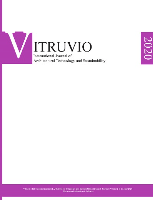
VITRUVIO-International Journal of Architectural Technology and Sustainability
Connecting researchers and practitioners for a greener future.Welcome to the VITRUVIO-International Journal of Architectural Technology and Sustainability, a leading open-access journal published by UNIV POLITECNICA VALENCIA, EDITORIAL UPV since 2015 and based in Spain. With its ISSN 2444-9091, this journal is dedicated to advancing the field of architectural technology and sustainability, providing a vital platform for researchers, professionals, and students alike. The journal has made significant strides in the academic landscape, achieving a Q3 ranking in Architecture and a Q4 ranking in Building and Construction for 2023. It features a diverse range of scholarly articles that explore innovative practices, cutting-edge research, and sustainable solutions in architecture. With a Scopus ranking placing it at #70/189 in Architecture and #161/223 in Building and Construction, it is positioned within the 63rd percentile and 28th percentile respectively, demonstrating its increasing impact in these vital fields. We invite you to engage with our content and contribute to the ongoing discourse around sustainability in architectural practice.
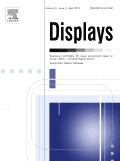
DISPLAYS
Elevating Standards in Display Research and TechnologyDISPLAYS is a prestigious journal published by Elsevier that focuses on the dynamic intersection of Electrical and Electronic Engineering, Hardware and Architecture, and Human-Computer Interaction. Since its inception in 1979, the journal has made significant contributions to advancing the field, currently holding a notable impact factor and ranking within the Q2 category across multiple disciplines, including Electrical and Electronic Engineering, Hardware and Architecture, and Human-Computer Interaction. With its broad scope, DISPLAYS is dedicated to publishing high-quality research that inspires innovation in display technology and its applications. Researchers and professionals benefit from access to cutting-edge findings in the realm of display systems, which are integral to the evolving landscape of digital interaction. Operating without an open access option, the journal ensures rigorous peer review, maintaining the highest standards of academic integrity and research quality. Positioned in the heart of the Netherlands, DISPLAYS continues to play a critical role in shaping future advancements, making it an essential read for anyone committed to these vital fields of study.
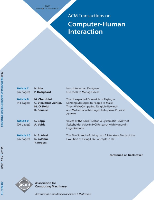
ACM Transactions on Computer-Human Interaction
Transforming User Engagement through Cutting-Edge StudiesACM Transactions on Computer-Human Interaction (ISSN: 1073-0516; E-ISSN: 1557-7325) is a prestigious journal published by the Association for Computing Machinery, focusing on the dynamic and rapidly evolving field of Human-Computer Interaction (HCI). With an impressive 2023 impact factor reflecting its high-quality research output, it proudly holds a Q1 ranking in the HCI category on Scopus, positioning it among the top journals in the field. Established in 1994, the journal has been a vital resource for researchers and professionals alike, featuring innovative studies that explore the design, evaluation, and implementation of user interfaces and interactive systems. Its broad scope encompasses various aspects of HCI, including cognitive processes, user experience design, and the social implications of technology. As an essential read for anyone involved in HCI research and practice, the journal is a gateway to advancements that shape the future of human-technology interactions. The journal is accessible to readers globally, and it plays a pivotal role in disseminating knowledge that drives excellence in software design and user interface research.
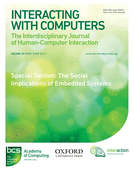
INTERACTING WITH COMPUTERS
Advancing Insights in Human-Computer InteractionINTERACTING WITH COMPUTERS is a renowned journal published by Oxford University Press, focusing on the interdisciplinary field of Human-Computer Interaction, as well as aspects of Library and Information Sciences and Software. With a rich history of publication since 1989, this journal has established itself as a significant platform for scholars to disseminate cutting-edge research and innovative methodologies that enhance our understanding of how humans engage with technology. Despite being classified in the Q3 and Q2 quartiles across various categories, its 2023 Scopus rankings highlight its relevance, positioning it within the 69th percentile for Library and Information Sciences. This makes it an essential resource for researchers, professionals, and students looking to stay informed about the latest advancements and discussions in this rapidly evolving domain. Though not currently open access, INTERACTING WITH COMPUTERS offers substantial insights that are crucial for driving forward the conversation in Human-Computer Interaction, ensuring its relevance in both academic and applied contexts.

Frontiers in Computer Science
Fostering collaboration for groundbreaking advancements in technology.Frontiers in Computer Science is a premier open-access journal published by Frontiers Media SA that has rapidly established itself as a prominent platform for scholarly research in the diverse and evolving field of computer science. With a notable impact factor reflecting its high citation rates, this journal aims to disseminate innovative findings and groundbreaking studies across multiple subdisciplines, including Computer Science Applications, Computer Vision and Pattern Recognition, and Human-Computer Interaction. Since its inception in 2019, and with a consistent trajectory from 2019 to 2024, it has garnered accolades, achieving Q2 ranking in several categories and an impressive Q1 in miscellaneous areas of computer science. Researchers, professionals, and students alike are encouraged to contribute to this dynamic journal that serves as a vital resource for advancing knowledge and fostering collaborative dialogue in the global computer science community. Frontiers in Computer Science is committed to providing open access to research, promoting unrestricted sharing of ideas and fostering innovation at the intersection of technology and society.

Multimodal Technologies and Interaction
Exploring the Future of User Experience.Multimodal Technologies and Interaction, published by MDPI since 2017, is an esteemed open-access journal based in Switzerland, dedicated to the exploration and advancement of innovative multimodal systems that enhance user experience across various digital platforms. With its commitment to disseminating high-quality research in diverse areas such as Computer Networks and Communications, Human-Computer Interaction, and Neuroscience, the journal has rapidly established itself within the academic community, achieving a commendable position in Scopus rankings including Q2 in both Computer Networks and Communications and Computer Science Applications. As an essential resource for researchers, professionals, and students alike, Multimodal Technologies and Interaction fosters interdisciplinary dialogue and supports the development of cutting-edge technologies, ensuring that advancements in multimodal interaction are accessible to a global audience. Scholars can benefit from its Open Access format, allowing unrestricted access to influential studies that shape the future of technology and interaction design.

ACM Transactions on Human-Robot Interaction
Advancing the Future of Human-Robot Synergy.ACM Transactions on Human-Robot Interaction, published by the Association for Computing Machinery, is a premier journal dedicated to advancing the field of human-robot interaction, a critical area within artificial intelligence and human-computer interaction. With a high impact factor and esteemed rankings, including Q1 in both Artificial Intelligence and Human-Computer Interaction, this journal serves as a vital platform for researchers, practitioners, and students aiming to explore innovative designs, methodologies, and applications that enhance the integration of robots in our daily lives. Covering research from 2018 to 2024, the journal encourages submissions that push the boundaries of knowledge and technology, contributing to the burgeoning dialogue on how robotics can be effectively and ethically integrated into human environments. Despite operating under a traditional access model, the journal's scholarly contributions play a crucial role in shaping the future of intelligent systems, making it an invaluable resource for anyone aiming to understand and influence the interaction between humans and machines.

Journal on Multimodal User Interfaces
Unveiling the Dynamics of Multimodal CommunicationJournal on Multimodal User Interfaces, published by Springer, serves as a vital platform for scholarly exchange in the rapidly evolving fields of Human-Computer Interaction and Signal Processing. Established in 2008 and continuing through 2024, this journal maintains a high profile in academia, currently ranking in the Q2 category for both fields, indicating its significant contribution to ongoing research and practical applications. With its Scopus rankings placing it at #34 in Signal Processing and #49 in Human-Computer Interaction, it is recognized for publishing high-quality, impactful research. Although it is not an Open Access journal, the Journal on Multimodal User Interfaces remains accessible through institutional subscriptions. Researchers, professionals, and students will find the journal an essential resource for advancing knowledge and fostering collaboration in multimodal interaction technologies, which are crucial for enhancing user experience and developing intelligent systems.

International Journal of Digital Multimedia Broadcasting
Bridging Disciplines in Digital BroadcastingThe International Journal of Digital Multimedia Broadcasting is a leading scholarly platform dedicated to the interdisciplinary exploration of digital multimedia broadcasting, published by HINDAWI LTD. With an ISSN of 1687-7578 and an E-ISSN of 1687-7586, this Open Access journal has made significant strides since its inception in 2008, ensuring wide accessibility and dissemination of research. Based in the United States, at Adam House, 3rd Flr, 1 Fitzroy Sq, London W1T 5HF, England, the journal covers a range of topics relevant to Communication, Electrical and Electronic Engineering, and Media Technology, boasting impressive Scopus rankings that highlight its influence in these fields. As part of the Q3 category in Communication and Electrical Engineering, and Q2 in Media Technology for 2023, the journal serves a vital role in fostering the understanding of technological advancements and their applications in multimedia broadcasting. Researchers, professionals, and students are encouraged to contribute to and benefit from the journal's rich repository of knowledge, paving the way for innovative developments in this dynamic industry.
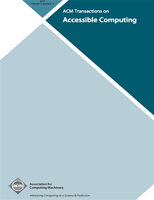
ACM Transactions on Accessible Computing
Pioneering advancements in inclusive design.ACM Transactions on Accessible Computing, with ISSN 1936-7228 and E-ISSN 1936-7236, is a prestigious journal published by the Association for Computing Machinery. Established to advance the field of accessible computing, this journal plays a critical role in promoting research that enhances the usability of computer technology for individuals with diverse accessibility needs. Its impact is reflected in its 2023 Scopus rankings, placing it in the Q2 category for Computer Science Applications and Q3 for Human-Computer Interaction, making it a significant resource for researchers and practitioners alike. With an ongoing publication timeline from 2008 through 2024, the journal not only contributes to theoretical advancements but also addresses practical implications in the realm of inclusive design and innovation. Although not Open Access, the journal is a vital forum for disseminating cutting-edge research, ensuring that advancements in technology are accessible to all.